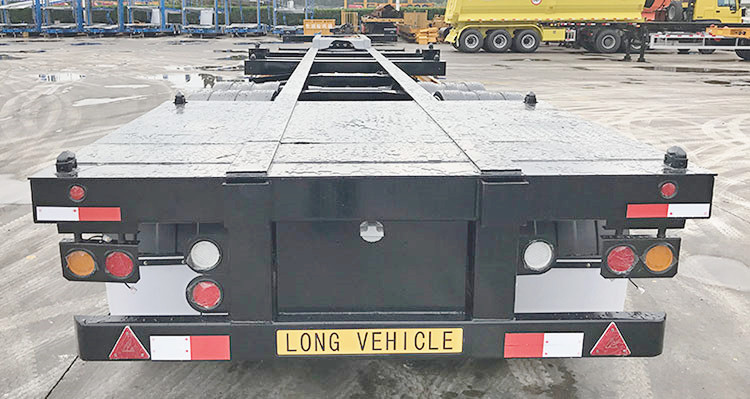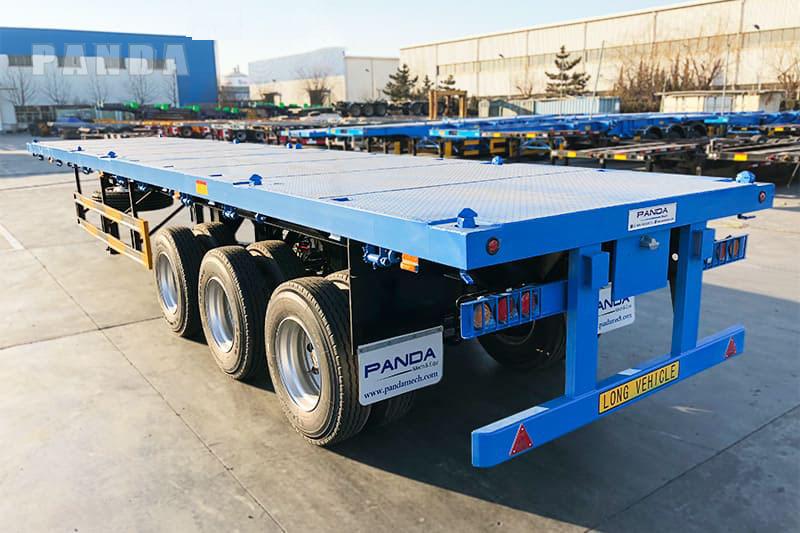Container chassis trailer is the semi-trailer that we come into contact with most in the logistics and transportation industry, but do you really understand it? Do you know its structure? Today, we will come together to talk about it. I hope to help you better understand the container chassis trailer.
1. Container Chassis parts
We are introducing the essential components of the container chassis trailer today: frame, locks, legs, wheel & tires, lights and electrical parts, fittings, and accessories.
- Frame
- Locks
- Axle
- Legs
- Wheels and Tires
- Lights and Electrical Components
- Suspension
- Side fenders
- Air Chambers
- Crash beam
- Cost
Frame
The container chassis frame serves as the backbone in transporting shipping containers. This sturdy steel structure is more than just metal; the reliable stage makes the logistics of moving goods possible. The frame securely holds the shipping container, allowing it to be easily transported from point A to point B—whether that’s from a ship at port to a warehouse.

Locks
These locks are the guardians of secure, efficient transport, holding shipping containers firmly in place on their chassis frames.

Designed to withstand forces that could shift or dislodge a container, these locks are crucial for safety during transport. They operate much like a seatbelt for shipping containers, ensuring that the precious cargo inside reaches its destination without a hitch.
Axle
Picture the axle of a container chassis as the backbone of the entire system, a bit like the main beam in a bridge. It’s this crucial piece of engineering that helps distribute the enormous weight of a loaded container evenly across the chassis and onto the wheels. Made from materials like high-grade steel, the axle is built to withstand not just the weight but also the constant motion and varying road conditions it will encounter.

What’s the axle’s job? It’s more than just holding up the wheels. In fact, it significantly impacts the vehicle’s maneuverability and stability. From taking sharp turns at a busy port to cruising along a long stretch of highway, the axle ensures that the container remains balanced and secure, minimizing risks of accidents.
Legs
Constructed from high-strength materials like steel, the legs provide a solid foundation, particularly when a container is at rest or being loaded and unloaded. They can be raised or lowered to meet the height of loading docks or to align perfectly with the cargo area of a ship.

Wheels and Tires
Built from durable materials and designed to handle substantial weight, these wheels and tires ensure that shipping containers reach their destinations safely and on time. They’re made to roll smoothly over everything from smooth highways to rough industrial yards, minimizing vibrations and impacts that could harm the container’s goods. There are also trailer bogie wheels.

Their application is as diverse as the goods they help transport. Whether it’s moving electronic gadgets, construction materials, or perishable goods, the wheels and tires of a container chassis are up to the task.
Lights and Electrical Components
These lighting fixtures, from brake lights to turn signals and specialized beacons, are specifically engineered to provide high visibility, even in the worst weather conditions. On the other hand, electrical components ensure that these lights are powered and connected to the driver’s controls. They’re like the nerves in a body, transmitting signals that activate the correct lights at the correct time.

Suspension
Made from robust materials and advanced engineering, the suspension system counteracts the roughness of the road or any uneven terrain. This is critical not just for the comfort of the journey but also for the safety and integrity of the shipping container and its valuable contents.

Whether the chassis is gliding down a well-paved highway or navigating the rugged grounds of an industrial yard, the suspension system plays a pivotal role. It ensures that bumps or vibrations don’t damage fragile goods and that heavier items don’t shift and destabilize the container. This makes it indispensable in various settings, from bustling ports to remote construction sites.
Side fenders
Made of durable materials like reinforced rubber or steel, these fenders are strategically placed along the sides of the container chassis. Their job is to absorb and deflect the force from any side collisions, thereby minimizing damage and keeping the container’s contents safe.

The applications of side fenders are both broad and essential. They’re particularly crucial in bustling port environments, where multiple vehicles move in close quarters. They’re also invaluable during highway travel, where debris or even minor collisions could pose significant risks. Simply put, they add an extra layer of security in an industry where the margin for error is slim.
Air Chambers
Constructed to withstand immense pressures, these air chambers convert the compressed air into mechanical force. When a driver hits the brakes, the air chambers activate, applying the force needed to bring the heavy, moving container chassis to a safe, complete stop.

Their application is crucial across various terrains and weather conditions. Whether navigating through a crowded port or barreling down a steep hill, the air chambers ensure reliable, consistent stopping power.
Crash beam
Crash beam as known as semi trailer bumpers. Constructed from high-strength steel or similarly durable materials, the crash beam is engineered to withstand significant force. It’s a line of defense, ensuring that even if there’s a collision, the damage is minimized as much as possible.

The application of the crash beam is particularly important in congested environments like ports, or on busy roads where the risk of collision is higher. It’s not just about preventing damage to the container and its contents, but it’s also a safety feature that can reduce the risk of injury in the event of an accident
Cost
Container chassis price: $5,000-12,000. (How much does a container chassis cost)
2. What is container chassis trailer?
Container chassis trailers are mainly used to transport containers. Its special locking mechanisms are integrated into the design to securely fasten the container, minimizing risks such as tipping over or sliding.

Made of robust steel, this container chassis trailer serves as the foundation upon which shipping containers are secured for land-based transport. Whether it’s carrying electronics, clothes, or food, the container chassis ensures everything gets to where it needs to go—safely and efficiently. Panda Mech supplies all sizes of container chassis trailers for sale.
Related: Best Guide Of Container Chassis Trailer
3. Type of container chassis trailer
Container chassis trailers have five types: standard container chassis, iso tank chassis, gooseneck container chassis, tilt chassis, and container side loader.



Read more: Type of shipping container trailer
Conclusion
Today there is about container chassis trailer parts end here, For some basic parts we have done a detailed introduction. For any related aspects of the problem, you are welcome to contact us at any time to consult us.
FAQ
What holds the tire to the axle
The studs poke through, and wheel nuts – also called lug nuts – are spun on and tightened, which holds the wheel onto the axle.



